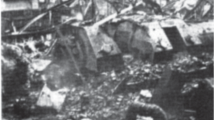Abstract
As experimental studies show, the rubbing of the rotor against the structure usually excites harmonics of different frequencies. In high-frequency regions, the power of the vibration signal appears to be considerable. The rotor—supports—stator system is in an unstable equilibrium state during the contact interaction between the rotor and the stator. The forces exerted on the rotor facilitate the excitation of the asynchronous rolling and its damping. The forces have been determined that facilitate the excitation of the progressive and retrograde rotor precession. The consideration of these forces in the algorithm for modeling the rotor-over-stator rolling development allows investigation of the impact of the components of the above forces on the behavior of the rotor system. The initial excitation—disturbance of the normal operation—of the rotor and subsequent unsteady oscillations of it result from sudden imbalance in the second span. The results of numerical modeling of the rubbing in the second span and the rotor-over-stator rolling upon change in the damping components of secondary (gyroscopic) components b ij (i ≠ j) of the damping matrix are presented for the rotor on three bearing-supports considering the synergetic effect of the forces of various types exerted on the rotor. It is shown that change in one of the parameters of the excitation forces leads to ambiguity of the pattern (manifestation form) of the asynchronous rotor-over-stator rolling and proves the existence of more than one states towards which the rotor—supports—stator system tends. In addition to the rolling with a constant rotor—stator contact, oscillations of the rotor develop in the direction perpendicular to the common trajectory of the precession motion of the rotor’s center with transition to the vibro-impact motion mode. The oscillations of the rotor tend towards the symmetry center of the system (the stator bore center). The reason is the components of the stiffness and damping forces that act in the direction transverse to the rotor’s motion trajectory. Recommendations are given for eliminating dangerous consequences of the development of the asynchronous rolling fraught with great financial losses.
Similar content being viewed by others
References
E. L. Poznyak, “Torsional impact in the shaft line at sudden and strong imbalance,” Mashinovedenie, No. 5, 66–74 (1987).
L. Ya. Banakh, “Contact problems in rotor systems,” in Proc. 22nd Int. Conf. on Vibroengineering, Moscow, Oct. 4–7, 2016; Vibroeng. Proc. 8, 90–96 (2016).
A. N. Nikiforov, “Generalized mathematical model of the Jeffcott-Laval rotor with consideration of its sliding on contact and misalignment with the stator,” Vestn. Nauchno-Tekh. Razvit., No. 5, 41–56 (2012).
V. F. Shatokhin, Doctoral Dissertation in Engineering (All-Russia Thermal Engineering Inst., Moscow, 2014).
V. F. Shatokhin, Oscillations of Turbounit Rotors with Generation Roll of the Rotor over the Stator. Modeling Methods and Software Tools (Lambert Acad., Dusseldorf, 2016).
V. F. Shatokhin, “Forces exciting generation roll at rotor vibrations when rotor-to-stator rubbing,” Therm. Eng. 64, 480–489 (2017). doi 10.1134/S0040601517070072
A. G. Kostyuk, V. F. Shatokhin, and O. A. Volokhovskaya, “Specific features relating to the motion of a rotor with rubbing against the stator,” Therm. Eng. 60, 628–634 (2013). doi 10.1134/S004060151309005X
A. G. Kostyuk, Dynamics and Strength of Turbomachinery: Textbook, 2nd ed. (Mosk. Energ. Inst., Moscow, 2000).
O. G. Zav’yalov, Doctoral Dissertation in Engineering (St. Petersburg State Univ., St. Petersburg, 2009).
V. F. Shatokhin, “Generation roll of the rotor over the water-lubricated bearing,” Therm. Eng. 65 (2) (2018) (in press).
E. L. Poznyak, Doctoral Dissertation in Engineering (All-Union Scientific Research Inst. of Electromechanics, Moscow, 1971).
A. G. Kostyuk, V. F. Shatokhin, and N. M. Ivanov, “Calculation of threshold power of large turbosets,” Teploenergetika, No. 3, 15–19 (1974).
Author information
Authors and Affiliations
Corresponding author
Additional information
Original Russian Text © V.F. Shatokhin, 2018, published in Teploenergetika.
Rights and permissions
About this article
Cite this article
Shatokhin, V.F. Patterns of the Rotor-over-Stator Rolling under Change in the Damping Components. Therm. Eng. 65, 143–150 (2018). https://doi.org/10.1134/S0040601518030060
Received:
Accepted:
Published:
Issue Date:
DOI: https://doi.org/10.1134/S0040601518030060



